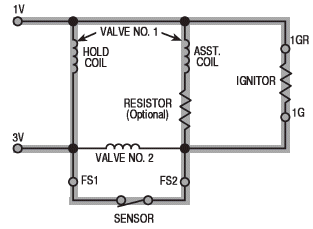

Dryers, gas or electric, are the simplest appliances you’ll ever work on. But judging by the amount and type of questions I get about gas dryers, specifically about the gas valve and burner, has prompted me to bring down another pearl of appliance wisdom from on high. This Appliance Repair Revelation explains how the burner in a gas dryer is controlled by these cute, button-looking coils on the valve, shown here to the right. Ok, hang on for some major geek-speak.
Many gas burners use a split coil
design. Valve No. 1 (see diagram below) has two coils to actuate its
plunger, thus giving the split-coil burner its name. Neither the hold coil nor the assist coil alone is strong enough to open the valve. The combined magnetic action of both coils is needed. Once the valve is open, however, the hold coil can hold it open by itself. The circuits of both coils will serve as a quick shut-off function.
When voltage is applied to 1V and 3V, a circuit is
completed from 1V to the ignitor, and through the
sensor to 3V as shown below.

Simultaneously, the hold coil is energized, and the
assist coil is energized through the radiant sensor.
This action means that the ignitor is heating and No.
1 valve is open. No gas flows, however, until No. 2
valve also opens. Note the resistor in series with the
assist coil. This is a balancing resistor which is used
only on one style of valve. It will not be present on all
split-coil valves.
The ignitor has reached a temperature sufficient to
open the radiant sensor contacts as shown below. This
action causes valve No. 2 to be energized through
the ignitor. Gas flows through the valve and is ignited
instantly by the still hot ignitor. Current through the
assist coil on valve No. 1 is very low at this point.
Magnetism created by the hold coil is sufficient to
hold the No. 1 valve open.

Another important thing to be aware of is that the radiant sensor is closed when it does not sense radiant heat and it opens when it does sense radiant heat. This means that in order to ohm out the sensor to verify its proper operation, you first need to make sure the sensing port is covered. In this condition, you should have a very low resistance reading between the terminals. Then, uncover the sensing port and hold a lit Bic lighter flame in front of the sensing port (yes, it has to be a Bic). In this condition, you should have a very high resistance reading (ideally, open) between the terminals. A bad sensor will also cause the meter reading to jump all around during either test.
Here’s a good reference on radiant sensors:
If you suspect the valve coils are burned-out, you can use your meter to make resistance measurements. The diagram below shows you what to measure:

Recommended reading:
- The Gas Dryer Problem Solver
- Hooking up a Gas Dryer
- Common Replacement Parts for Whirlpool/Kenmore Gas and Electric Dryers
For more information on your dryer or to order parts, click here.



